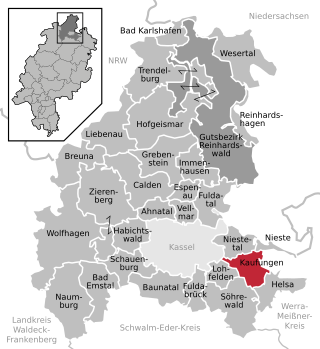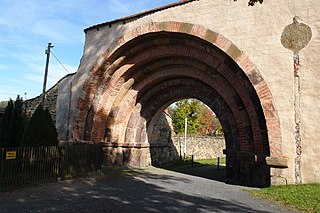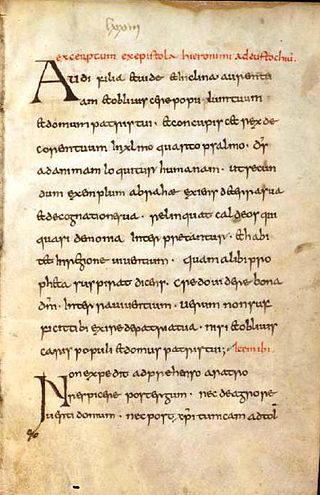
Kaufungen Abbey (German : Kloster Kaufungen) was a Benedictine nunnery founded in 1017 by the Empress Cunigunde of Luxembourg, wife of Henry II, Holy Roman Emperor, located in Kaufungen in Hessen, Germany.

Kaufungen Abbey (German : Kloster Kaufungen) was a Benedictine nunnery founded in 1017 by the Empress Cunigunde of Luxembourg, wife of Henry II, Holy Roman Emperor, located in Kaufungen in Hessen, Germany.

In May 1017 Cunigunde was staying on the imperial estate of Kaufungen when, according to Thietmar of Merseburg, she became seriously ill and vowed to found a monastery if she recovered. She did so and her husband Henry endowed the new foundation in 1019.
King Henry granted to the nuns of Kaufungen, the privilege to organize a weekly market each Saturday, and a fair on the Feast of John the Baptist, and another of the Feast of the Exaltation of the Holy Cross. [1]
After the death of Henry in 1024, Cunigunde, who was later canonized as well as her husband, became a nun in the new Benedictine monastery, [2] where she died around 1033.
The abbey church was consecrated on 13 July 1025. In 1089, the nunnery became an Imperial abbey, territorially and judicially independent, subject only to the Holy Roman Emperor .
The "Vögte" (advocates, or lords protectors) of Kaufungen Abbey were the Counts of Maden.
During the 12th century, the abbey was transformed to house a community of secular canonesses, becoming a home for unmarried female members of the nobility (Frauenstift). It continued in this form until 1509, when, at the instigation of William II, Landgrave of Hesse, the abbey was returned to the Benedictine Order, under the authority of the Bursfeld Congregation. The canonesses were formed into Benedictines by nuns from Gehrden Abbey.
In 1532, during the Protestant Reformation, Landgrave Philip I of Hesse appropriated it and gave it, together with Wetter Abbey, to the Hessische Ritterschaft (Hessian Knighthood, an association of noble families for the purpose of mutual help) for the care and shelter of female members of those families belonging to it.
As the Ritterschaftliches Stift Kaufungen it still exists today.
The abbey church, now known as the "Stiftskirche", was dedicated on 13 July 1025. It is now used as the parish church and is counted as the most significant structure of the late Ottonian period in north Hesse. In the westwork the Imperial gallery ("Kaiserempore") was re-discovered in 1938. [3] [4] [5] [6] The church hosts regular classical music concerts.
Cunigunde of Luxembourg, OSB, also called Cunegundes, Cunegunda, and Cunegonda and, in Latin, Cunegundis or Kinigundis, was Empress of the Holy Roman Empire by marriage to Holy Roman Emperor Henry II. She ruled as interim regent after the death of her spouse in 1024. She is a saint and the patroness of Luxembourg; her feast day is 3 March.

Kaufungen is a municipality in the district of Kassel, in Hesse, Germany. It is situated in the narrow valley of the river Losse, surrounded by the steep, wooded hills of the Kaufunger Wald, approx. 10 kilometres east of Kassel.
Engelthal Abbey or St. Mary's Abbey, Engelthal, is a Benedictine nunnery in the Wetterau region, Hesse, Germany.

Eibingen Abbey is a community of Benedictine nuns in Eibingen near Rüdesheim in Hesse, Germany. Founded by Hildegard of Bingen in 1165, it was dissolved in 1804, but restored, with new buildings, in 1904. The nuns produce wine and crafts. They sing regular services, which have been at times recorded. The church is also used as a concert venue. The abbey is a Rhine Gorge World Heritage Site.
Buchau Abbey, otherwise the Imperial Abbey of Buchau, was a self-ruling Imperial Estate and its abbess had a seat and vote at the Imperial Diet.

Saint Blaise Abbey was a Benedictine monastery in the village of St. Blasien in the Black Forest in Baden-Württemberg, Germany.

Baindt Abbey, otherwise the Imperial Abbey of Baindt, was a Cistercian nunnery in Baindt in the district of Ravensburg in Baden-Württemberg, Germany.

Göss Abbey is a former Benedictine nunnery and former cathedral in Göss, now a part of Leoben in Styria, Austria. After the abbey's dissolution in 1782 the church, now a parish church, was the seat of the short-lived Bishopric of Leoben.

The Niedermünster or Niedermünster Abbey, Regensburg, was a house of canonesses (Frauenstift) in Regensburg, Bavaria, Germany. At the height of its power it was one of the wealthiest and most influential in Bavaria. The church is still in use as the parish church of Regensburg Cathedral.

The Obermünster, or Obermünster Abbey, Regensburg, was a collegiate house of canonesses (Frauenstift) in Regensburg, Bavaria, second only to Niedermünster in wealth and power.

Beatrice I, also known as Beatrice of Franconia, was Abbess of Gandersheim Abbey from 1043 and Princess-Abbess of Quedlinburg Abbey from 1044 until her death.

Altzella Abbey, also Altzelle Abbey, is a former Cistercian monastery near Nossen in Saxony, Germany. The former abbey contains the tombs of the Wettin margraves of Meissen from 1190 to 1381.
Hedwig of Gudensberg, also known as Hedwig of Hesse (1098–1148) was German regent: she served as regent of Thuringia during the minority of her son Louis II from 1140.
Giso IV, Count of Gudensberg was a German nobleman. He was a Count in the Upper Lahngau and from 1121, he was Count of Gudensberg in Lower Hesse and Imperial Standard Bearer. During his lifetime, the Gisones dynasty reached the peak of its power, its largest territorial expanse and the largest number of bailiff positions.

Sonnefeld Abbey is a former Cistercian nunnery in Sonnefeld in Bavaria, Germany. The former abbey church, or Klosterkirche, is now an Evangelical Lutheran parish church.

The Synods of Aachen between 816 and 819 were a landmark in regulations for the monastic life in the Frankish realm. The Benedictine Rule was declared the universally valid norm for communities of monks and nuns, while canonical orders were distinguished from monastic communities and unique regulations were laid down for them: the Institutio canonicorum Aquisgranensis. The synods of 817 and 818/819 completed the reforms. Among other things, the relationship of church properties to the king was clarified.